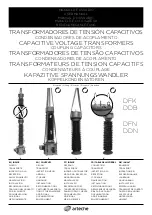
______________________________________________
HARRIS
888-9058-001
WARNING: Disconnect and lockout AC primary power prior to servicing
20
Each slave controller controls a cabinet’s fan motor, 50 volt DC supplies, and RF amplifier
modules. Slave controllers also report cabinet door interlock status, air interlock status,
module faults, and power supply faults to the main controller.
Cabinet input drive and RF power output samples, detected by RF peak detectors, are
relayed to the main controller through the slave controllers as well.
In the event of loss of the main controller, each slave may be used to operate its amplifier
cabinet for emergency service.
1.2.7 50 Volt Power Supplies
Each PA cabinet has one or two 50 volt supplies, depending on system configuration.
These supplies convert the AC power to 50 volts DC for the RF amplifier modules. Each is
rated at 300 amps, and regulated to hold the transmitter power stable despite power line
voltage changes. Internal fault protection is interfaced to the slave controller.
1.2.8 RF Amplifier Modules
Only two types of RF amplifier modules are used in the aural and visual chains of any
given Platinum transmitter system:
1.2.8.1 Power Amplifiers (PAs)
PAs are used primarily as final amplifiers. Each is capable of supplying 1,050 watts RF
output, either aural CW or visual peak sync. PAs are also used as inter-stage amplifiers in
larger visual cabinets, to drive several subsequent parallel PA modules. PAs are single-
stage amplifiers, consisting of paralleled class AB amplifiers.
1.2.8.2 Driver Modules
Driver modules provide high gain. Primarily used in preamp applications to drive PAs, they
are also used as aural final amplifiers in low power applications. Driver modules are keyed
so that they cannot be plugged into a PA slot.
Low band drivers contain two cascaded class A stages. High band drivers contain two class
A stages and one class AB stage. In both cases, the final stage in a driver consists of two
paralleled amplifier blocks.
1.2.9 Visual Signal Flow Path
A basic visual signal flow topology is common to all
Platinum Series
transmitters. For the
following discussion, refer to the transmitter block diagram in the drawing package.
1.2.9.1 Exciter
Video is applied to the exciter where it is clamped, pre-corrected for differential gain and
differential phase, and modulated onto the IF carrier (37 MHz for system M/NTSC,
38.9MHz for B/PAL). Next, frequency response and group delay are corrected. Vestigial
sideband filtering follows. The IF signal then passes through an AGC amplifier to
correctors for linearity and ICPM. A local oscillator and mixer in the exciter upconvert the
















































